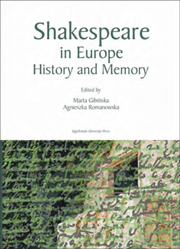Book contents
- Frontmatter
- Contents
- Preface
- Towards a European History of Henry V
- History and Histories
- History and Memory: Criticism and Reception
- History, Memory, and Ideological Appropriation
- Theatre: The Act of Memory and History in the Making
- Shakespeare Remembered by his Stuart Successors: Reflections on the 2005 “Gunpowder Season” at the Swan Theatre in Stratford
- “Who's there?” – Macbeth on the London Stage 2004–2005
- Stillness in Hamlet
- “Blood Sprinkled or Blood Spilt:” the History of Richard II Revisited in the Contemporary Theatre
- The Memory of Architecture: New Thoughts on Reconstructing old Theatres (The Case of the Gdańsk Fencing School)
- Index of Authors
Stillness in Hamlet
from Theatre: The Act of Memory and History in the Making
Published online by Cambridge University Press: 05 September 2014
- Frontmatter
- Contents
- Preface
- Towards a European History of Henry V
- History and Histories
- History and Memory: Criticism and Reception
- History, Memory, and Ideological Appropriation
- Theatre: The Act of Memory and History in the Making
- Shakespeare Remembered by his Stuart Successors: Reflections on the 2005 “Gunpowder Season” at the Swan Theatre in Stratford
- “Who's there?” – Macbeth on the London Stage 2004–2005
- Stillness in Hamlet
- “Blood Sprinkled or Blood Spilt:” the History of Richard II Revisited in the Contemporary Theatre
- The Memory of Architecture: New Thoughts on Reconstructing old Theatres (The Case of the Gdańsk Fencing School)
- Index of Authors
Summary
In Elsinore, instructing the actors who are getting ready to perform The Murder of Gonzago, a ghost play that is also a Mousetrap set to catch his father's killer, Hamlet begins by remembering other players, other performances: “O, there be players that I have seen play […]” (III.2.33–34). In New York, when Live Schreiber began those same instructions in Andrei Şerban's 1999 production for the Public Theatre, Hamlet was literally faced with remembering those players and performances, that is, faced with Hamlet's history. As he spoke, cast members entered carrying posters of Hamlets past:
Ralph Fiennes, lately of Broadway, [was] there, along with the Public's own Sam Waterston, Kevin Kline and Diane Venora (borne by Ms. Venora herself, this production's Gertrude), plus the celluloid princelings Laurence Olivier, Mel Gibson and Kenneth Branagh, not to mention John Barrymore and Sarah Bernhardt […] Last and largest in the parade is a blow-up of Mr. Schreiber, so big that it takes two actors to carry it. They enter just in time to illustrate the final words of Hamlet's critiques: “They imitated humanity so abominably.”
These still photographs, ghosts of previous Hamlets and Hamlets, are symbolic travellers who return to inform Şerban's production and remind his Hamlet of the world of theatre history he himself will enter. More clearly than anywhere else in this production, the scene reads Elsinore as the theatre, the most appropriate place for Hamlet to remember his father(s) and the likeliest space for actors and audience to make sense of Hamlet.
- Type
- Chapter
- Information
- Shakespeare in EuropeHistory and Memory, pp. 291 - 302Publisher: Jagiellonian University PressPrint publication year: 2008

